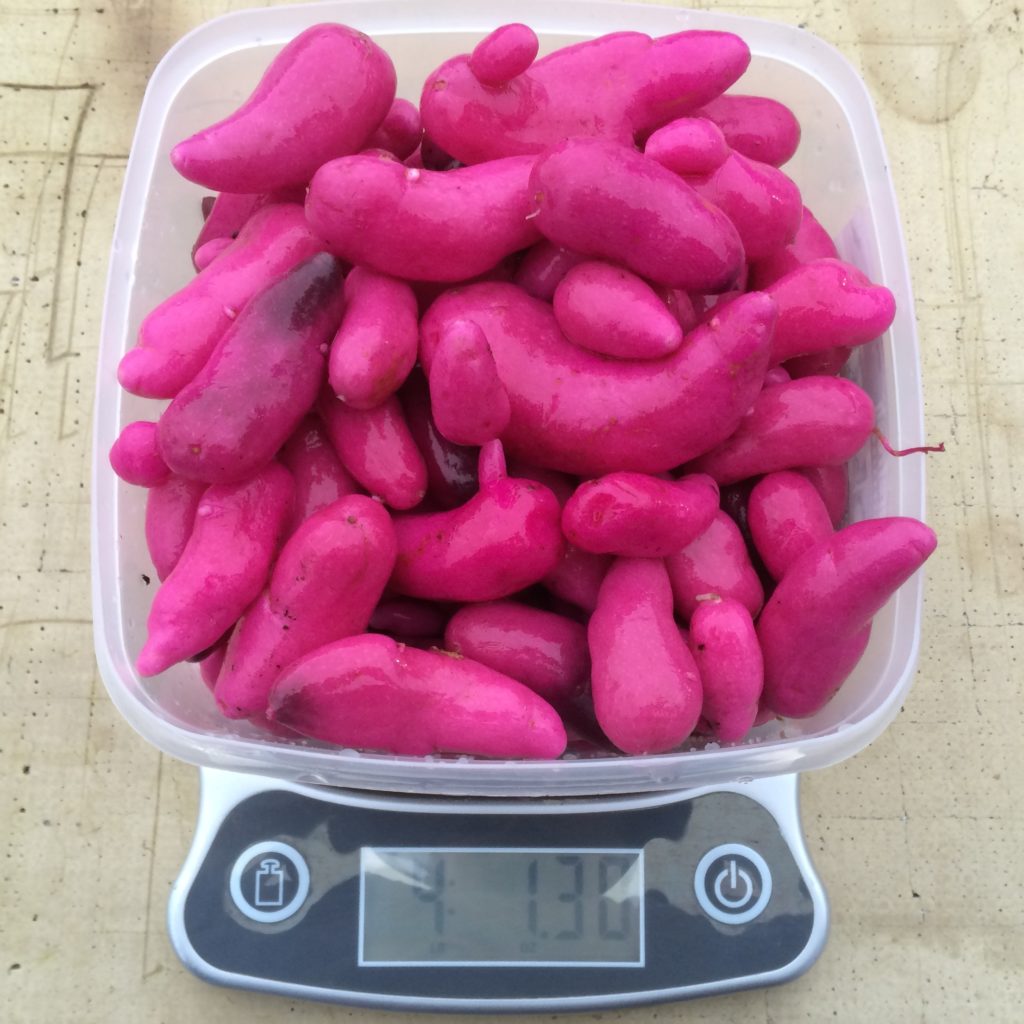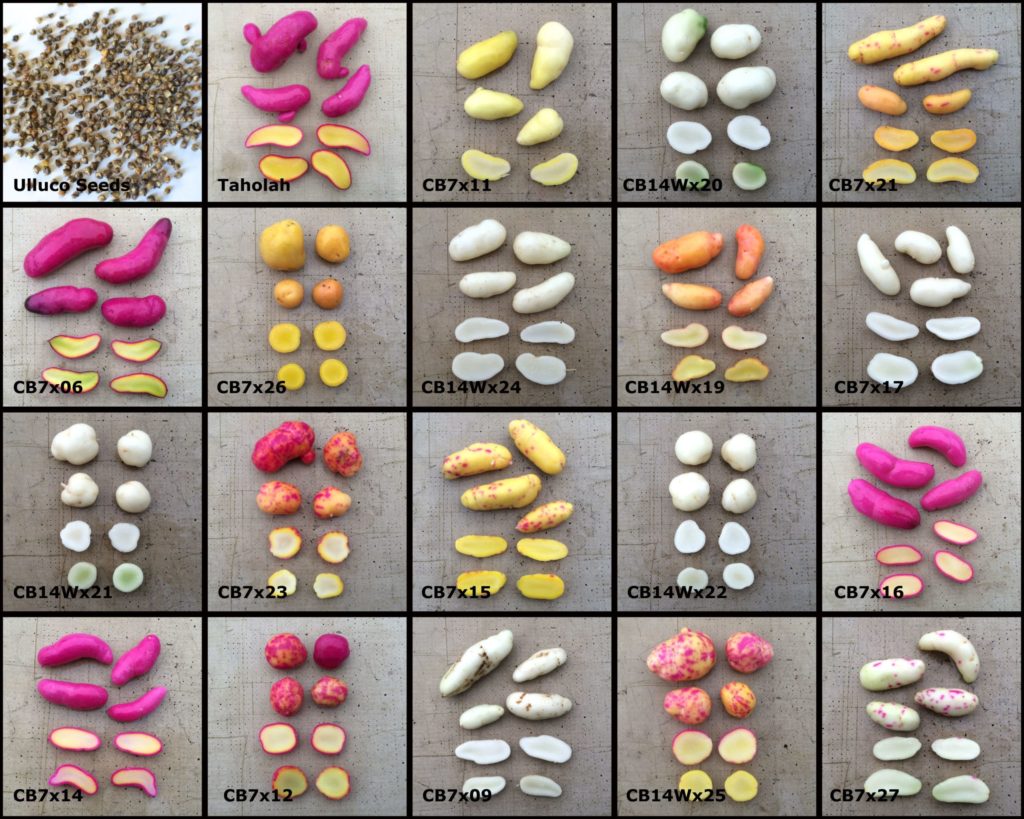Blog, ulluco (Ullucus tuberosus)
Ulluco: 2016 Wrap Up
Unveiling new ulluco varieties is starting to become a little routine. Oh well, there is really no rut that I would rather be stuck in.
I reached a peak of 44 ulluco seedlings this year. 25 of them died, were culled due to obvious disease, or failed to set any tubers. 19 survived to the end of the growing season. Five turned out yields of a pound or more, ranking them with the better heirlooms. One of them, now named Taholah, yielded more than four pounds. The rest turned out less impressive yields, but they seem to improve in the second year, when grown from tubers.
I noticed more variations in flavor and texture this year. Some varieties have a very pronounced geosmin/beet flavor, while others have very little. I also noticed differences in the perception of “starchiness,” which I think is a combination of flavor and texture. One variety has very little geosmin flavor and also very little starchy flavor and this produces an effect similar to water chestnut. They also range considerably in mucilaginousness (I hope that is a valid noun), from almost watery to a level of sliminess that I can’t compare to anything polite. One of the white ones was so much slimier than any ulluco that I have ever tasted that I spit it out. The worst part is that it was one of the white ones and I lost my tasting notes, so I will have to discover it again. Thankfully, most of them were pretty close to what I now perceive to be the median.
All of these varieties will live on as breeding lines, at least through next year. Every one of them set seed, which is very encouraging. The average across all 19 varieties was just about 50 seeds per plant. That is a substantial improvement over the parent varieties. I still have only gotten seed from about half of the heirlooms and amounts so small from some that it will take years to get one that germinates.
You might notice the large number of white varieties. This is very interesting to me, since none of the grandparent heirloom varieties were white. Neither were any of the parent first generation crosses. This is the beginning of puzzling out ulluco’s color genetics, which should be fun, although it will take a while since it is hard to produce statistically useful numbers of seedlings.
Also note the number of spotted varieties. It has been an open question in my mind whether spots arise from somatic mutations or chimerism or whether they are inherited. It seems pretty clear at this point that spots can be inherited.
The star of this year’s crop now has a name: Taholah. It will take its place along with last year’s star varieties, Moclips and Humptulips, in the catalog next year, assuming that nothing goes askew between now and then. (Incidentally, these aren’t just funny names that I made up; they are towns on the Washington coast.) It has been submitted to the Open Source Seed Initiative as our newest open source variety.

Taholah produced an astounding four pounds of tubers. While this would be merely respectable in the Andes, it is quite a feat here. Taholah began forming tubers in August, more than a month before the autumn equinox. Since all of the heirloom varieties are short day tuberizers and produce nothing before the equinox, this is potentially a very big development. I hope for a repeat performance next year.
I collected about the same amount of seed as last year: just over a thousand. I could have probably collected five times as much with so many varieties with improved fertility, but it is my time that limits the amount of seed that I can produce. Hand pollinating ulluco is a slow, painstaking process with a low success rate. I hope to see more seeds forming in the future without hand pollination. I do see that on occasion and, with fertility on the rise, perhaps there will come a point where the plants take care of themselves.
There is still a long way to go. The long game centers on wider climate tolerance and day neutral tuberization, without losing any ground in flavor or appearance, but the short term is focused almost entirely on improving fertility.



man, i gotta say, I’m loving this blog.
have you guys ever considered doing some youtube videos or something?
showing the processes you use to manage these projects?
i would watch it.
i mean there are far fewer videos demonstrating hand pollination than you would think.
We’ve talked about doing some videos, but I’m a lot more comfortable with writing. I’ll add your vote to the pile though – you aren’t the first to ask. Thanks!
Fantastic stuff, I am curious did Taholah live up to expectations in 2017?
We had severe flooding in 2017 that damaged the crop, so I couldn’t really evaluate. It was still higher yielding than most varieties, but yields were far from normal.
That is a pity, fingers crossed 2018 is better. I guess that also means you don’t know if any of your new seedlings are even earlier/higher yielding.
I could make some observations last year, but the flooding made absolute yield observations pointless. Taholah is definitely earlier. Plants dug in August had tubers. The only question is whether or not this is useful earliness. It was not accompanied by the descending stolons that form most of the tubers on ulluco. The largest tubers on ulluco are typically those that immediately surround the seed tuber and that are not formed from descending stolons. My assumption has been that they are the largest simply because they are able to begin forming earlier while descending stolons are still growing toward the soil. With Taholah, there was almost a two month gap between the first tubers and the initiation of descending stolons. So, now I wonder if these two stages of tuber formation might be under separate control. That would be weird, but not impossible I guess. What I hope to see from a legitimately early variety is both tuber and descending stolon initiation at the same time.
That is very interesting, if the largest tubers are those that surround the seed tuber perhaps the separation of the two types of tuber initiation could be leveraged to increase average tuber size and the percentage of the crop that is marketable?